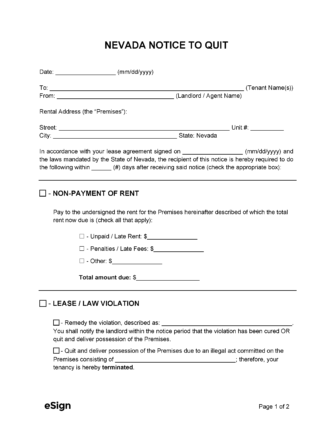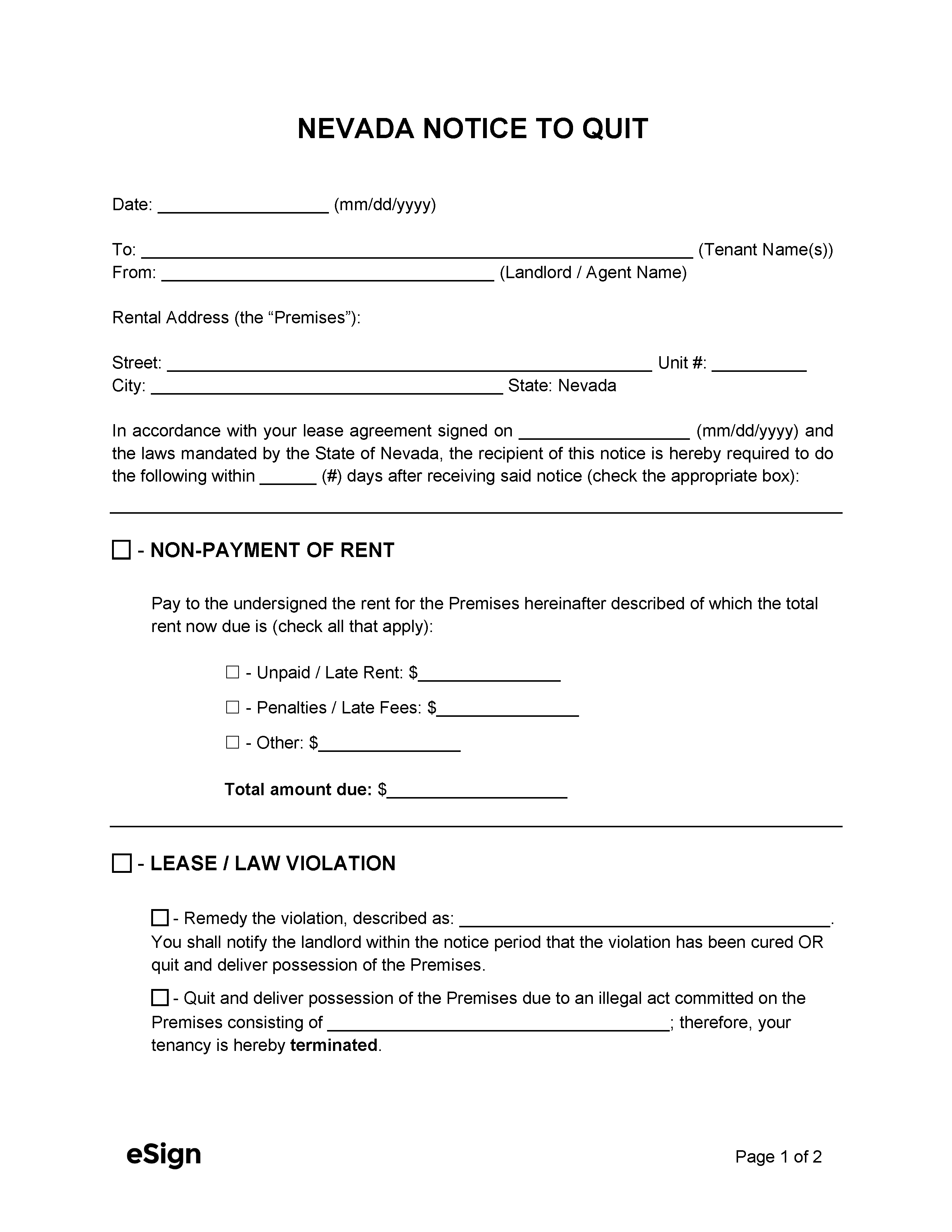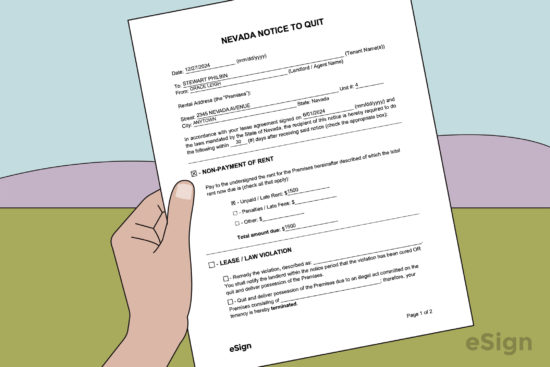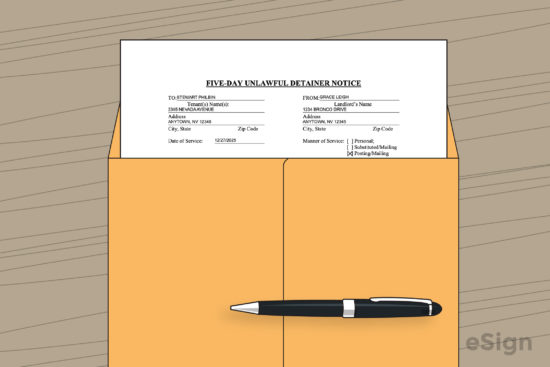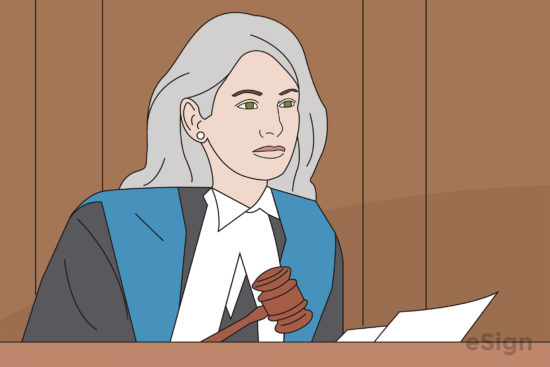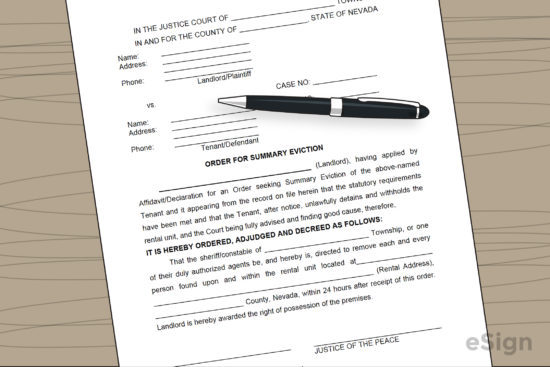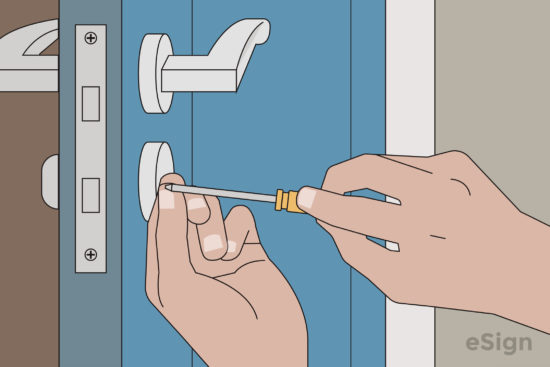Eviction Notices: By Type (8)
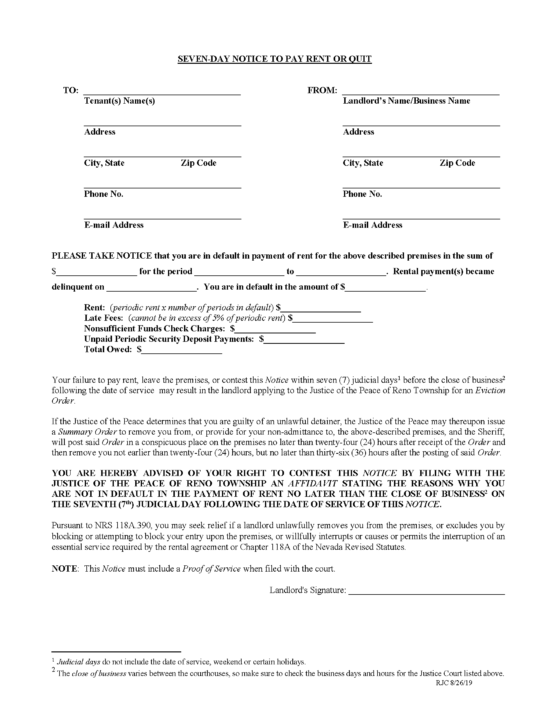 7-Day Notice to Quit | Non-Payment – Used when a tenant has not paid their rent in full. 7-Day Notice to Quit | Non-Payment – Used when a tenant has not paid their rent in full.
Download: PDF |
 5-Day Notice to Quit | Non-Compliance – If a tenant has violated the terms of their lease, this notice orders them to fix the problem or move out. 5-Day Notice to Quit | Non-Compliance – If a tenant has violated the terms of their lease, this notice orders them to fix the problem or move out.
Download: PDF |
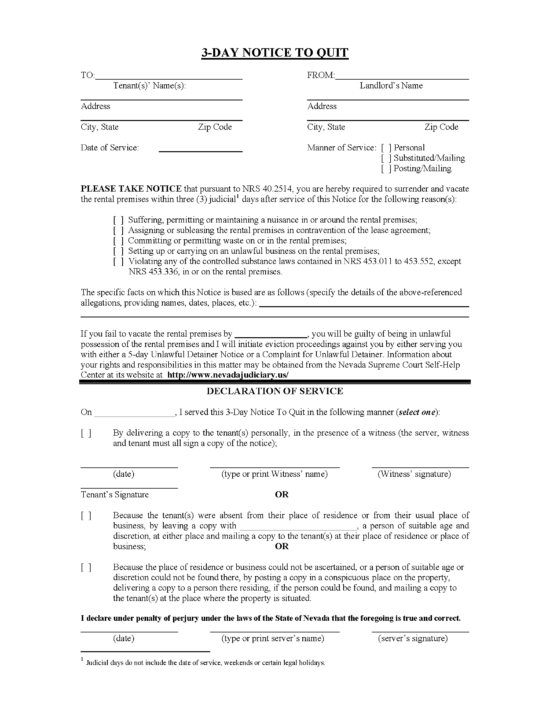 3-Day Notice to Quit | Severe Non-Compliance or Illegal Activity – Used for tenants who have committed severe lease violations or illegal activities on the rental property. 3-Day Notice to Quit | Severe Non-Compliance or Illegal Activity – Used for tenants who have committed severe lease violations or illegal activities on the rental property.
Download: PDF |
5-Day Notice to Terminate Tenancy-at-Will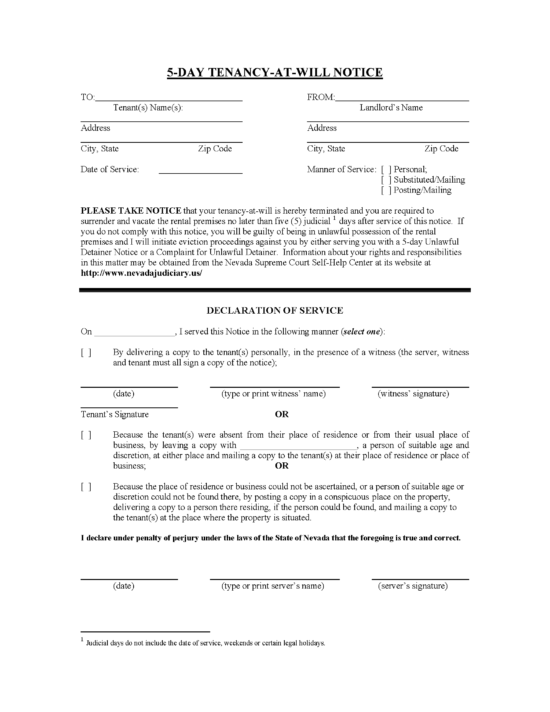 – Terminates an at-will rental agreement with five days’ notice. – Terminates an at-will rental agreement with five days’ notice.
Download: PDF |
7-Day Notice to Terminate Week-to-Week Lease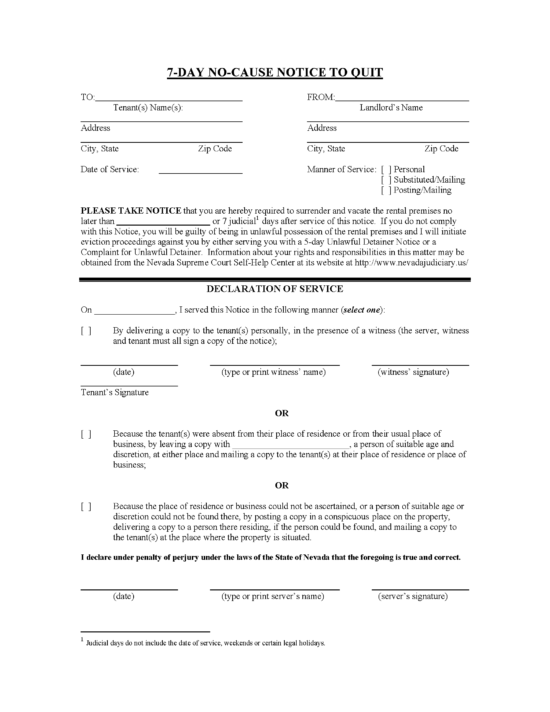 – Used by the landlord to terminate a week-to-week lease agreement. – Used by the landlord to terminate a week-to-week lease agreement.
Download: PDF |
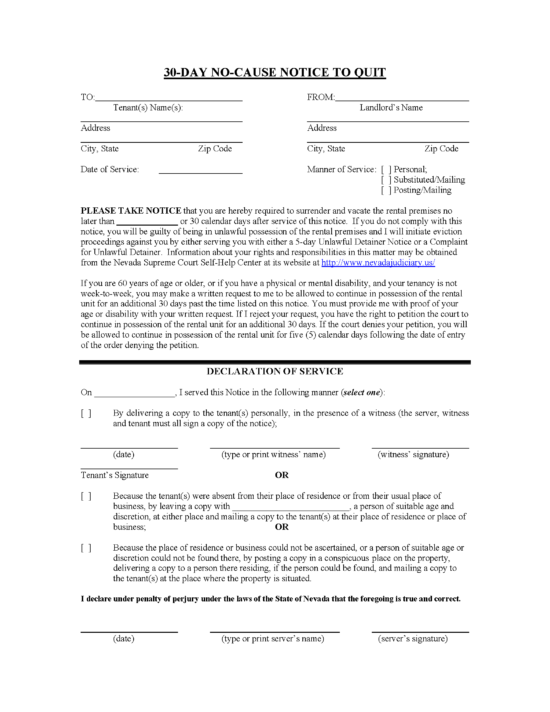 30-Day Notice to Terminate Month-to-Month Lease – Terminates a monthly or periodic (other than weekly) lease and gives the tenant 30 days to move out. 30-Day Notice to Terminate Month-to-Month Lease – Terminates a monthly or periodic (other than weekly) lease and gives the tenant 30 days to move out.
Download: PDF |
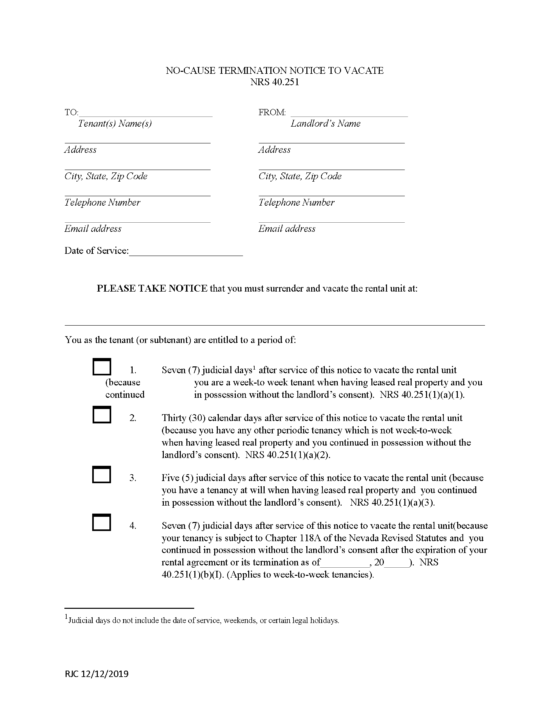 Notice to Terminate – This document can be used to terminate a weekly, monthly, periodic, or at-will tenancy with the appropriate notice period. Notice to Terminate – This document can be used to terminate a weekly, monthly, periodic, or at-will tenancy with the appropriate notice period.
Download: PDF |
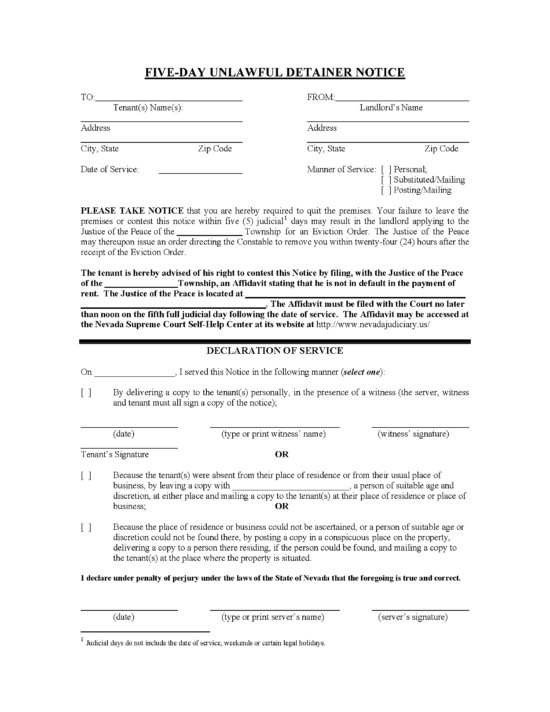 5-Day Notice to Quit | Unlawful Detainer – Used to evict a tenant who illegally holds over the rental property. 5-Day Notice to Quit | Unlawful Detainer – Used to evict a tenant who illegally holds over the rental property.
Download: PDF |
Notice Requirements
How to Evict a Tenant in Nevada
Summary vs. Formal Eviction
In Nevada, there are two eviction processes that a landlord may pursue to remove a tenant from their rental property:
Summary Eviction (described in the instructions below):
- Doesn’t require an attorney
- More quickly resolved
- Processed by Justice Court
- Landlord cannot seek damages in their eviction case (must file a separate suit)
Formal Eviction:
- Attorney required
- Mandatory for mobile homes, commercial tenants, and following foreclosures
- Filed with District Court if landlord seeks damages in excess of $10,000
- Filed with the Justice Court if landlord seeks damages of $10,000 or less
Step 1 – Notice to Quit
Before the landlord can file for eviction, they must arrange to have the appropriate notice properly served on the tenant and, depending on the notice type, obtain a declaration of service.
Step 2 – Unlawful Detainer (If Applicable)
If the tenant does not comply with the first notice, the landlord must serve a 5-Day Notice to Quit (Unlawful Detainer) on them before filing for eviction. This notice gives them five days’ notice to contest the eviction or move out.
Exception – If the eviction is for non-payment of rent, this notice is not required, and the landlord can skip this step.
Step 3 – Tenant’s Answer
If the tenant chooses to contest the eviction, they will need to file the appropriate response with the local Justice Court within the given notice period or the court will issue a default judgment against them.
Step 4 – File Eviction Documents with Circuit Court
After the notice expires, the landlord will need to file a Complaint for Summary Eviction with the Justice Court in the district where the rental property is located after the notice expires.
The following completed documents must also be filed with the Complaint:
- Copies of all eviction notices served on the tenant
- Proof of mailing (if applicable)
- A copy of the written lease agreement (if any)
- Civil Court Cover Sheet (if tenant hasn’t filed Answer)
Step 5 – Attend Hearing
If the tenant files an Affidavit within the given notice period, the Justice Court will notify the tenant and landlord of the scheduled hearing date. At the hearing, both parties will be given the opportunity to present their case, and the court will reach a verdict.
Failure of either individual to appear in court could result in a default judgment against them. If the tenant wins the case, they can continue their tenancy and may be entitled to damages.
Step 6 – Eviction Order
If the court rules in the landlord’s favor, they will grant an Order for Summary Eviction. At this juncture, the tenant can file a Motion to Stay (SAMPLE) in an attempt to delay the eviction for 10 days.
Note – If the tenant is non-compliant and didn’t file an Affidavit, the court will issue this order without a hearing.
Step 7 – Removal of Tenant
The court will send the Order for Summary Eviction to a local constable to post on the tenant’s door within 24 hours.
Within 24 to 36 hours of the notice being posted, the tenant will be locked out and, if necessary, removed from the property.
Court Forms + Resources
Forms
- Complaint for Summary Eviction (Other than Non-Payment of Rent) – Sample
- Signed by: Landlord/Agent and Witness
- OR Landlord/Agent and Notary Public
- OR Landlord/Agent’s sworn affidavit under penalty of perjury
- Signed by: Landlord/Agent and Witness
- Complaint for Summary Eviction for Non-Payment of Rent – Sample
- Signed by: Landlord/Agent and Witness
- OR Landlord/Agent and Notary Public
- OR Landlord/Agent’s sworn affidavit under penalty of perjury
- Signed by: Landlord/Agent and Witness
- Tenant’s Affidavit (Non-Payment of Rent) – Sample
- Signed by: Tenant and Notary Public
- OR Tenant’s sworn affidavit under penalty of perjury
- Signed by: Tenant and Notary Public
- Tenant’s Affidavit (Other than Non-Payment of Rent) – Sample
- Signed by: Tenant and Notary Public
- OR Tenant’s sworn affidavit under penalty of perjury
- Signed by: Tenant and Notary Public
- Motion to Continue in Possession – Sample
- Signed by: Tenant
- Motion to Stay – Sample
- Signed by: Tenant and Justice of the Peace
- Order for Summary Eviction
- Signed by: Court Official
Resources
